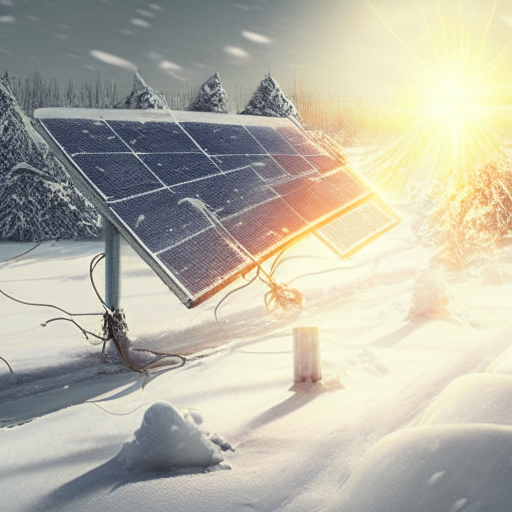Maximize Solar Energy Efficiency in Extreme Cold Weather Conditions
As a dedicated survivalist, you undoubtedly recognize the importance of achieving self-sufficiency, especially when facing the formidable challenges posed by harsh winter weather. One of the key concerns you may encounter is how to effectively harness renewable energy solutions in subzero temperatures. Although the bitter cold can seem like an insurmountable barrier, there's no cause for alarm! This article will delve into the untapped potential of solar power in frigid climates. We will unveil innovative strategies that empower you to effectively harness solar energy, even during the most severe winter conditions, by adopting a proactive and informed approach to your energy needs.

Contrary to popular belief, many individuals mistakenly assume that solar electricity generation is only viable in warm, sun-bathed regions. However, thanks to remarkable advancements in technology, capturing solar energy in colder climates is not only possible but increasingly effective. Let’s explore the various techniques that enable solar power systems to excel in extreme cold, and how you can leverage this sustainable, eco-friendly energy source to enhance your lifestyle and survival strategies significantly. Understanding these principles will allow you to utilize solar power efficiently, regardless of the weather.
To start, it is crucial to understand that solar panels harness energy from sunlight rather than heat. While cooler temperatures can influence the efficiency of solar panels, they do not render them ineffective during winter months. By implementing strategic planning and innovative techniques, you can enhance the performance of your solar power system, ensuring optimal operation even in the coldest environments. Gaining insight into the mechanics of how solar panels function under varying temperatures will empower you to make informed decisions that align with your energy requirements and sustainability goals.
One vital factor in optimizing solar electricity production in cold climates is the angle and orientation of your solar panels. Proper alignment can significantly increase the amount of sunlight your panels receive throughout the day. During winter, the sun’s trajectory shifts lower in the sky, making it essential to tilt your panels at a steeper angle. This adjustment maximizes sunlight capture, thereby improving their efficiency. Additionally, orienting the panels towards the south can further enhance their sunlight collection capabilities, which is especially beneficial during the shorter days characteristic of winter months.
Another major challenge in colder regions is the accumulation of snow, which can obstruct the effectiveness of your solar panels. A heavy layer of snow can drastically reduce energy output. However, by proactively addressing this issue, you can implement effective solutions. Consider installing snow barriers or heating elements on your solar panels to prevent snow buildup. These enhancements facilitate the melting of existing snow and ensure continuous energy production, even during snowstorms. Regularly clearing snow by hand also serves as an effective maintenance strategy, keeping your panels free from obstructions and functioning optimally throughout the winter.
Integrating battery storage systems into your solar energy setup is a forward-thinking strategy that can significantly enhance solar power efficiency in cold conditions. These batteries store excess energy generated during daylight hours, making it available when sunlight is scarce or temperatures drop. The importance of battery storage becomes particularly evident in freezing conditions, as it ensures a reliable supply of electricity when it is needed most. By investing in a high-quality battery system, you can maintain your energy independence and be well-prepared for any unforeseen circumstances that may arise during extreme weather events.
Selecting the right type of solar panels is crucial for optimizing your solar energy system’s performance in cold climates. Some panels are specifically engineered to perform better at lower temperatures and may utilize enhanced insulation or specialized materials designed to minimize the negative effects of frost and ice. By making an informed choice about the panel types best suited for your cold environment, you can maximize energy output and ensure that your solar power system effectively meets your energy demands throughout the winter months.
Beyond technical considerations, it is essential to have your solar power system installed by professionals who possess experience in cold climate conditions. Skilled installers can provide the best practices for installation, ongoing maintenance, and troubleshooting, offering invaluable insights into how to optimize your system. Their expertise will help guarantee that your solar setup operates at peak efficiency, even in the most challenging winter conditions, ultimately enhancing the reliability and resilience of your energy source.
Maintaining a proactive and prepared mindset is vital in survival scenarios. While solar power can serve as a dependable and effective energy source in cold climates, having backup generators or alternative energy solutions is equally important. These additional measures act as a safety net in case of extended periods of low sunlight or unexpected system failures. By integrating solar power with other renewable energy sources, you can further bolster your energy independence and resilience, ensuring that you are thoroughly equipped to tackle any weather-related challenges that may arise.
Solar energy is not limited to warm and sunny regions; it holds tremendous potential even in the harshest climates, provided it is strategically planned and technically advanced. By adjusting your panel angles, mitigating snow accumulation, incorporating battery storage, selecting suitable solar panels, relying on skilled installation, and establishing contingency plans, you can unlock the full potential of solar energy in extreme cold. Embrace renewable energy with confidence and resourcefulness, securing your survival and sustainability in any climate.
The post Solar Energy in Extreme Cold: Unlocking Its Full Potential appeared first on Survival Bite.
The Article Solar Energy’s Full Potential in Extreme Cold Conditions Was Found On https://limitsofstrategy.com





Comments are closed